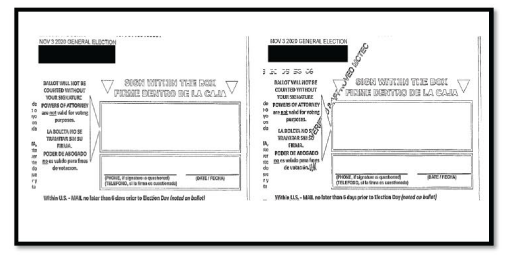PHOENIX — The presentation of findings released Friday, September 24 by the team of people hired to review Maricopa County’s 2020 General Election, stirred up a hornet’s nest of allegations on social media and alternative news sites.
One of the initial claims laid out was that 17,322 duplicate ballots were cast among the county’s more than 1.9 million early votes. That claim was then picked up by local allies of former President Trump such as State Senator Wendy Rogers and former news anchor, now GOP gubernatorial candidate Kari Lake.
Maricopa reported ZERO duplicate ballots.
— Kari Lake for AZ Governor (@KariLake) September 24, 2021
Real total is 17,322.
This is more than enough to change the election result. https://t.co/wsru0E0VHO
Wow I bet Al Gore wished he had 17k duplicate votes hit 1-5 days after the election in Florida. Hanging chads are nothing compared to this madness.
— Wendy Rogers (@WendyRogersAZ) September 24, 2021
Is there any veracity of the claim? Could 17,322 duplicate votes have been cast in the state’s largest county?
Envelopes, not ballots
On Friday, the claim was made early in the three-hour-long presentation by Dr. Shiva Ayyadurai, an MIT-educated technologist that was an early supporter of Trump’s claim that the election was stolen.
Dr. Shiva, as he is called, was a speaker at a sponsored event in Phoenix by Republican legislators in late November. That is where he alleged that county election equipment secretly “decimalized” votes, awarding 1.3 votes for Joe Biden for every .07 Trump vote. This has been widely debunked multiple times.
Dr. Shiva was a late addition to the State Senate’s audit, only recently securing a contract through his company EchoMail to analyze the signatures on 1.9 million ballot envelope images. Those images were handed over to the senate by the county.
During his presentation, Dr. Shiva noted that there were 17,322 duplicate images present in the dataset. Most duplicates only showed up twice, but there were a few instances in which a duplicate image was present three or four times.

At this point, a critical shift of language occurred during the presentation where Dr. Shiva referred to the two-copy duplicate images and stated, “each of these voters submitted two ballots.”
This is misleading.
In Maricopa County, early ballots are processed by Runbeck Election Systems, who receive the ballots in bulk and scan them into software that allows election workers to compare signatures on the envelopes to signatures in the voter registration database. By law, early ballot envelopes cannot be opened until the identity of the voter is confirmed, typically using their signature.
Megan Gilbertson, a county spokesperson, told ABC15 that a duplicate image most often occurs when a signature is left blank or there is a question on it.
When this happens, the sealed envelope is elevated to another level of verification where the voter is contacted to “cure” the signature. The voter is then positively identified by either obtaining a signature, or in some rare medical instances, assisted by an election official as they are no longer able to sign their name. Cured envelopes are hand stamped as verified and re-scanned by Runbeck so they can be properly marked in the check-in database.
This also explains a secondary claim made by Dr. Shiva that some envelope images had a stamp mark that appeared to be placed under a large arrow telling voters where to sign. Dr. Shiva suggested that the images appeared to be photoshopped.
When reached for comment, Runbeck Elections said that the images from the county’s green envelopes are compressed into a space-saving image format that converts the black arrows to white. If election officials stamp the envelope anywhere inside this arrow, it would appear below the arrow in the scan.

Photo shows a Maricopa County early ballot envelope (above)

Processed image of the signature region (above)
A less common occurrence is when there is a “household exchange.” Former Maricopa County election official Katheryn Coleman said that this happens when people in the same household inadvertently sign an envelope meant for another person in the household and vice versa. When this happens, the envelopes follow the same process as any other envelope deemed questionable.
Only after this extensive process is the ballot removed from the envelope. Meaning that while duplicate envelope images can occur, they only represent one ballot that will be counted.
Dr. Shiva’s own analysis of the images found duplicate occurrences to be exceedingly rare. Less than 1 percent of the envelope images were duplicates.



